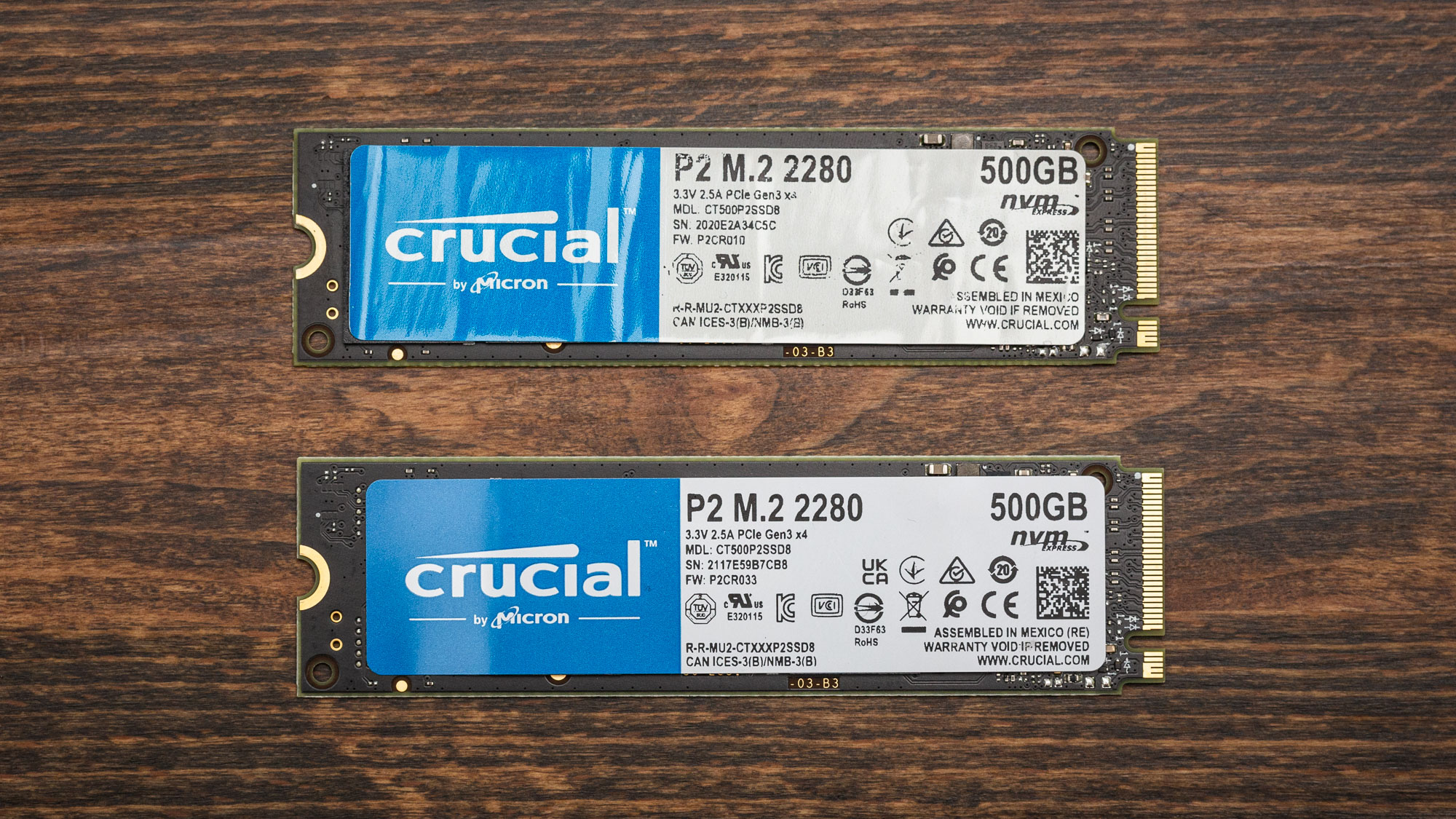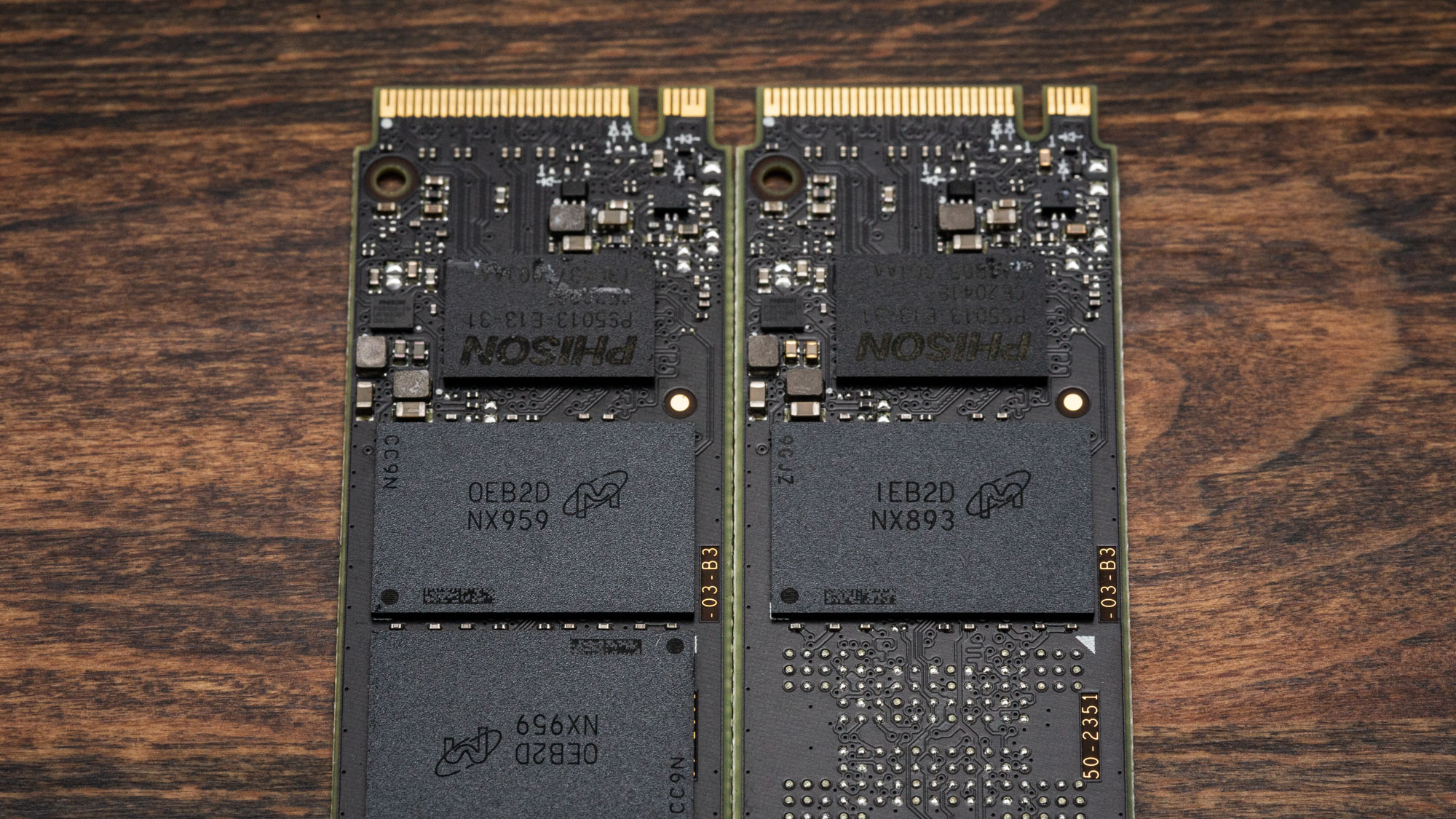Unsavory Flash Swap: Re-Testing Crucial’s P2 SSD After QLC Downgrade
Crucial’s P2 now ships with QLC flash, making it a poor performer and an even worse value.
Crucial’s P2 wasn’t much of a contender for the title of the Best SSD when it first launched, but now it’s firmly on our do not recommend list. Recently, Crucial decided to swap out the P2’s TLC flash with slower and less-endurant QLC flash, making the new P2 much worse than the original version. For instance, the QLC version of the drive performs at roughly one-quarter the speed of the original when transferring files, read speeds are half as fast in real-world tests, and sustained write speeds have dropped to USB 2.0-like levels of a mere 40 MBps. That’s slower than most hard drives. Unfortunately Crucial made the change without altering the product name or number or issuing an announcement. Crucial claims that the P2 will live up to its specs because the company baked the performance of QLC flash right into the spec sheet at launch. But those specs don’t match the performance you’ll see in numerous reviews of the originally-shipping drives, resulting in yet another misleading component swap from an SSD manufacturer.
Sound familiar? Just as Adata has been under fire for deceptive tactics, Crucial is now in the hot seat for doing the same. Unlike Adata, Crucial has kept the P2’s SSD controller the same, but swapping TLC flash for cheaper, slower, and less durable QLC can be even more detrimental to performance.
Changing components in any product can happen due to a variety of reasons, like to assure component supply or cut costs, but now even the more reputable SSD manufacturers are becoming more aggressive. While these companies say the modified SSD will meet or exceed the specs of the original, this is mainly true for only one portion of an SSD’s performance — the synthetically measured sequential performance of the SLC cache. That doesn’t reflect the true performance penalties that can occur during real-world use.
Depending on the modification to the initial design, the performance ramifications can be very deceiving if you don’t know what to look for. While the sequential read and write performance can be in line with the spec sheet, random performance and sustained write speeds can vary greatly and severely impact real-world performance. That’s bad news for new buyers on the hunt for their next storage upgrade, especially if they’ve read reviews with higher benchmarks of a drive with the same name that isn’t, well, the same drive they’ll purchase at retail.
In the case of Crucial’s P2, we typically don’t expect companies that make their own NAND to engage in this practice. However, Crucial did set a precedent last year when it released a second SKU of it’s BX500 when it swapped from TLC to QLC NAND. The issue this time around is that the company hasn’t changed the model number or branding at all. Instead, these new P2 SSDs secretly replace the original model we received for review.
Crucial says the P2 lives up to the P2’s specs because it accounted for lower QLC performance when it launched the drives. We did notice the abnormally low performance specs during our initial review: The drive consistently beat its spec’d performance, leading us to believe something was ‘off.’ The 500GB model was only rated to deliver write speeds of up to 940 MBps, which didn’t line up with what we saw in our testing as our sample managed to dish out writes of over 1.8 GBps.
This left us with an uneasy feeling when it came to the future of the P2, and now we know the reason. While these new QLC P2 variants may live up to the company’s spec sheets, just like we saw with Adata’s XPG SX8200 Pro, they most definitely do not live up to the original’s performance. Unfortunately that means the benchmarks you’ll see in every review of the original P2 SSDs paint a misleading picture that isn’t representative of the actual performance you’ll get with the drives.
A Closer Look
Externally, the two revisions of the SSD look nearly identical (original on top, replacement below). The packaging, label over the top of the drive, and even the PCB and component placement are mostly identical on our new sample. The only differentiator is that the new QLC variant has UK/CA printed on the packaging near the model number, and the new firmware revision. There are also two fewer NAND flash packages on our new sample, but that is well hidden under the drive’s label. The reduced number of chip packages comes because each package of QLC NAND stores more data, thus reducing the number of packages needed. That saves Crucial money.
Get Tom's Hardware's best news and in-depth reviews, straight to your inbox.
As mentioned, the controller stays the same in both variants. Both utilize Phison’s E13T, a single-core, DRAM-less design optimized for cost-effectiveness and low power consumption. However, the original leveraged Micron’s TLC flash while the new one leverages Micron’s 1Tb 96L QLC (N28A) flash. The issues plaguing the P2 are multi-faceted, though; it’s not just the type of flash that is to blame for the performance issues we see with this new sample. It’s also tied to die density, how many dies are used, and, based on the new SSD’s S.M.A.R.T. data, possibly lowered power limits, too.
After some further digging with new SSD analysis tools we have on hand, we found that even our original sample doesn’t even have the 96L TLC that the company claimed it did. Instead of 512Gb 96L TLC as it should have been, our original sample came with the company’s 256Gb 64L TLC (B16A) flash. Presumably, this tactic was to use up the company’s last supplies of the flash before swapping to the 512Gb 96L flash it had started mass-producing at the time. This means there may be another variant of this drive in the wild that comes with performance that lands between these two, too.
These stats are important to note due to the influence that die density, die count, and interface speed directly have on an SSD’s performance. While leveraging higher density flash can help to reduce cost-per-GB and the number of components compared to drives built with less dense flash, it can also have a detrimental effect on performance.
SSD’s use algorithms that increase the interleaving of data for fast, responsive data access. Therefore, if an SSD controller can take advantage of more flash dies for greater interleaving capability, or faster interface speeds, higher performance can be attained. The inverse is also true, so fewer packages means slower performance.
Crucial’s new 500GB P2’s flash operates at similar interface speeds as the original (800 MTps), however, with only four dies that are four times the density (now 1Tb instead of 256Gb), the QLC-powered P2 can’t match the performance the original had with 16 total dies, especially in sustained write workloads.
MORE: Best SSDs
MORE: How We Test HDDs And SSDs
MORE: All SSD Content

Sean is a Contributing Editor at Tom’s Hardware US, covering storage hardware.
-
occational_gamer Tom's Hardware should update its original review to point to this updated article. Crucial is banking on consumers finding the original reviews.Reply
Also, in addition to the regular "Best..." and "Editor's Choice" articles, there should be one listing all the models that should be avoided, based on shady manufacturer changes and updated reviews. -
Alvar "Miles" Udell Even if it did have its original TLC flash, The Samsung 980 500gb is on sale right now at B&H for $60, and that makes it a no brainer for a "budget" drive. The only negative there is the 1TB version often dips under $100.Reply -
hotaru251 Why do ppl not petition for a law that mandates if you change a critical part of something it is requried by law to have a new product id/name to let ppl know this..Reply
imagine buying a telsa and finding out it has a cheap electrical car battery/engine and not telsa's quality ones. yes, both will work, but they are not what u wanted to buy. -
Fubarr Given that there are plenty of dram + SLC cache equipped QLC drives out there (Microcenter’s Inland Platinum line being a good example), nobody should be plunking down money for garbage like this Crucial crap. Micron is pretty foolish for playing games with their brand image.Reply
That said, there’s a real mess (for consumers) to wade through in the NVMe market. The biggest problem is the huge gulf that’s opened up between “prosumer” grade TLC drives (e.g. Seagate Firecuda 510/520/530, Samsung 980 Pro, Inland’s “Premium” line) and the mainstream QLC drives. The TLC drives offer substantially better sustained write performance and TBW ratings in the 1000’s for 2TB drives. In contrast, the QLC counterparts, have issues with sustained writes and comparatively short endurance.
For example, (apples to apples) Inland’s 2TB Premium NVMe (TLC) drive has a TBW of 3,200 (for $249.99), versus their 2TB Platinum QLC drive (for $199.99), which has a TBW of just 450. If you’re workload is write intensive (large local dev builds, involving container and VM provisioning; people doing AV work, etc.), 450 TBW is not hard to burn through in just a few years. Yet many technical users, let alone consumers, are aware of these fundamental differences.
Throw in nonsense like Crucial’s part swapping, and it becomes even harder to understand what your getting. Layer in the final issue of OEM’s, like Dell and Lenovo, being completely opaque about what (generally crummy) SSD you’ll be getting, and you now have most people completely in the dark about the real performance or durability of a quantifiably limited-life computer component. IMHO, that’s an unacceptable state of affairs. -
escksu Quietly swapping TLC for QLC, this is way worse than what Adata did.Reply
Frankly, I could accept QLC with a large SLC cache provided the price reflects this. Since the average person hardly needs to write 50-100GB of data at once, the SLC cache is sufficient. However, quietly swapping the TLCs out to boost profit margins is terrible. -
escksu ReplyUSAFRet said:BSAB.
Haha, just when you thought what Adata did was unscrupulous, Micron take it to a whole new level. -
Krotow Oh, so Crucial too stepped into Adata and Kingston shoes. It is sad. Well, thanks about warning. I hope that they din't managed to cripple their 2.5" SATA MX500 line yet.Reply


